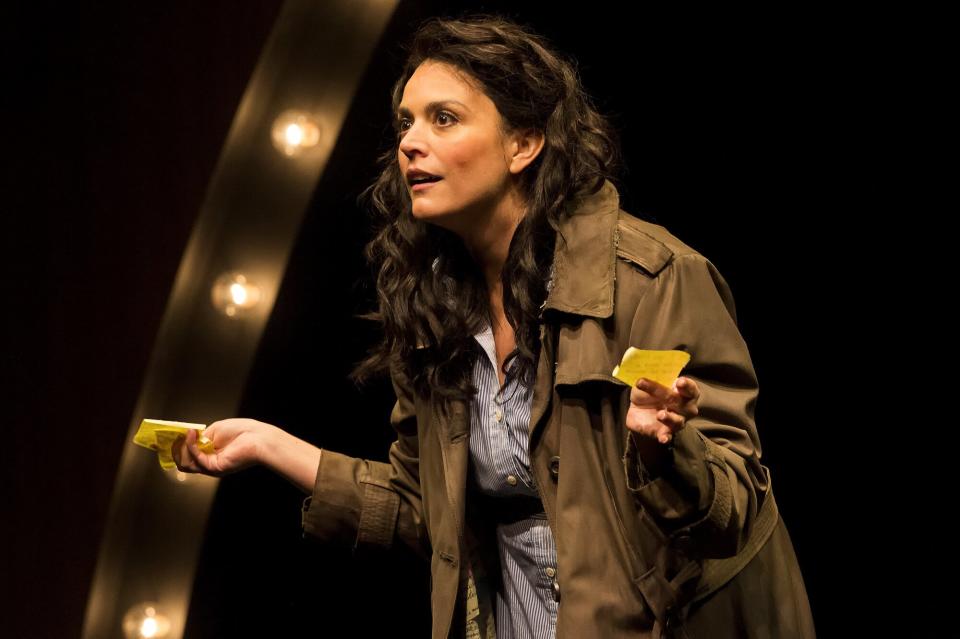The Search for Signs of Intelligent Life in the Universe review: Cecily Strong shines
The play is soup, the audience is art…
So concludes The Search for Signs of Intelligent Life in the Universe, Jane Wagner's one-woman show that explores the feminist movement, theater as art form, and the challenges of trying to change the system from the inside.
Wagner's 1985 play is practically synonymous with its original star Lily Tomlin (who also starred in a 1991 film adaptation), but it gets new life via Saturday Night Live star Cecily Strong, now playing at Los Angeles' Mark Taper Forum.
The story follows Trudy, a "bag lady" who tells us she and her extraterrestrial friends are traveling forward and backward in time to observe human life. Through those travels, Strong takes on the persona of everyone from a handful of women involved in second wave feminism to a teenage performance artist to a male gym rat.
At first, Strong could be enacting a series of SNL sketches brought to life — Trudy bears vestiges of her Weekend Update character Cathy Anne, a.k.a. the woman always yelling outside Michael Che's window — and there are glimmers of other favorites, including The Girl You Wish You Hadn't Started a Conversation with at a Party and Kyra from Girlfriends Talk Show.

Craig Schwartz Cecily Strong in 'The Search for Signs of Intelligent Life in the Universe'
But as the play proceeds, the threads of connection between each character becoming increasingly evident, Strong also sinks into the pull of the storytelling. As the writing itself moves from comedic caricature to real human beings, a lovely depth emerges in Strong's work. She could easily have rested on the laurels of her SNL schtick, but she pushes beyond that to something much more emotionally resonant and lived in.
One-person shows are great feats of acting — the precision, the stamina, and the memorization required staggering in and of themselves (not to mention, the task of holding the audience's attention completely on your own). But Strong takes that all a step further, morphing from one character to the next with a stunning alacrity and physical totality that is rather breathtaking in its sleight of hand.
She's aided by marvelous lighting design from Lap Chi Chu and transformative sound design by Jeff Gardner that help ground her physical and vocal shifts in a surreal version of reality. Gardner's sound design in particular makes it easy to forget that Strong doesn't have any actual props beyond a stack of post-its; through his sonic cues and Strong's impeccable timing, we see the apple she bites into or the gym locker she closes as vividly as if it were there on stage.

Craig Schwartz Cecily Strong in 'The Search for Signs of Intelligent Life in the Universe'
Wagner's play hits different in this Post-Roe era. As the second half of the action focuses nearly entirely on Lyn, Edie, Marge, and Pam — women engaged in second wave feminism — it offers both a glimpse of a not-so-far-away past and a startling relevancy. The transition into this space occurs with the Supreme Court's announcement of the Roe vs. Wade decision, and the weight it settles over both Strong and the audience is palpable. The play interrogates the ways in which second wave feminism challenged and upheld the status quo, and how, as Lyn puts it, we thought we were changing the system, but the system changed us.
Previously, those words from Wagner felt like an indictment of capitalism, of the inexorable demands of being a career woman, wife, and mother — the myth of "having it all" and the sacrifices we make in the name of that unreachable goal. Now, they feel like a death knell, a commentary on how this country's determination to push us backwards has rendered those hard-won victories despairingly futile.
Search for Signs can be a wildly uneven play, one that is easy to get distracted by as audiences attempt to fit together how each piece of the puzzle of characters meshes with another. There's still an element of that here, but Strong's radiant performance lifts the text away from that in its closing moments.
All of these interactions with this at times zany, at times painfully real cast of characters do, in fact, amount to something. A commentary on art itself, the ways in which theater is a unifying force — not just for seemingly disparate characters, but for the audience itself.
Because a play is nothing without its audience, the beauty of its collective gasps, laughs, and attentive silences. The art isn't the text alone, it's just…soup. To truly live, to convey a sense of intelligent life in the universe, to move from soup to art, it needs a witness. B+
Related content:

 Yahoo Movies
Yahoo Movies 